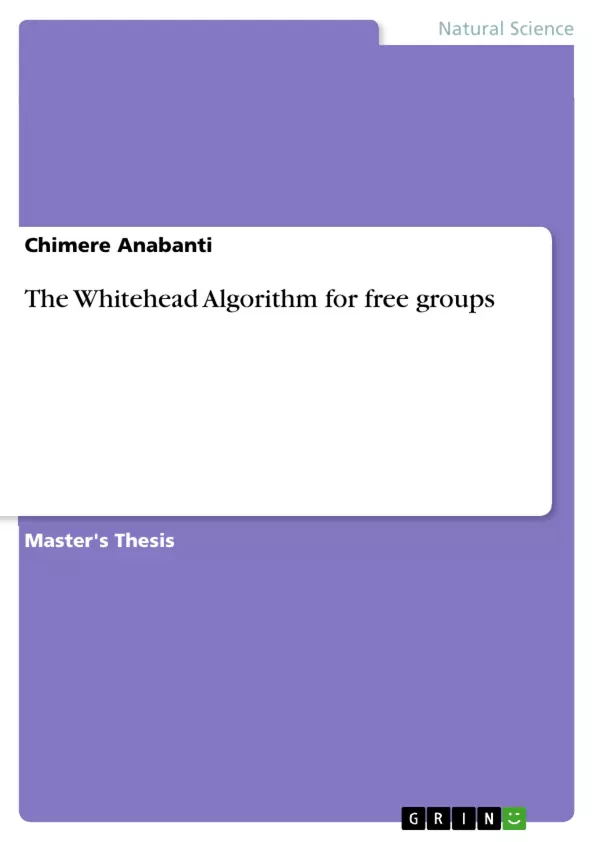We start with a brief introduction to Free Groups, thereby appreciating Nielsen’s approach to the
Subgroup theorem. Beautiful results of J. H. C. Whitehead, J. Nielsen, E. S. Rapaport, Higgins and
Lyndon, and J. McCool form our building block. We study different automorphisms of a finitely generated
free group as well as a finite set of automorphisms which Whitehead used to deduce that if two elements
of a finitely generated free group are equivalent under an automorphism of the group, then they are
equivalent under such automorphisms. We write program aimed at appreciating Whitehead’s theorem,
starting with programs for appreciating Whitehead automorphisms to programs for determining whether
two elements of a finitely generated free group are equivalent or not. We conclude by classifying all
minimal words of lengths 2, 3, 4, 5 and 6 in F n (for some n ∈ [2, 6]) up to equivalence.
Inhaltsverzeichnis (Table of Contents)
- Introduction to Free Groups
- Definition, Existence and Uniqueness Theorem
- Basic Properties of Free Groups
- Subgroups of Free Groups
- Automorphisms of Free Groups
- Special Automorphisms of FX
- Automorphisms of Fn
- Nielsen Automorphisms
- The Whitehead Automorphisms
- Equivalence of Elements under Aut(Fn)
- A Presentation for Aut (Fn)
- The Whitehead Algorithm
- Whitehead Theorem Revisited
- Algorithm Developments
- GAP Exhibitions
- Concluding Remarks
- Summary
- Further Research Questions
Zielsetzung und Themenschwerpunkte (Objectives and Key Themes)
This work explores the Whitehead Algorithm for free groups, a fundamental concept in group theory with applications in computational algebra and topology. The primary objective is to delve into the mathematical foundation of the algorithm, analyze its implementation, and investigate its significance in classifying elements within free groups.
- Free Groups: The concept of free groups, their properties, and how they relate to group presentations.
- Automorphisms of Free Groups: The study of various automorphisms of free groups, particularly the Whitehead automorphisms, and their role in equivalence relations within the groups.
- The Whitehead Algorithm: An in-depth exploration of the algorithm, its development, and its applications in determining the equivalence of elements within free groups.
- Classification of Minimal Words: Using the Whitehead Algorithm to classify minimal words in free groups of varying ranks.
- Computational Aspects: The implementation of the Whitehead Algorithm using computational tools and its applications in solving group-theoretic problems.
Zusammenfassung der Kapitel (Chapter Summaries)
Chapter 1: Introduction to Free Groups
This chapter introduces the fundamental concept of free groups, defining them through their universal property. It covers the existence and uniqueness theorem, outlining the key characteristics of these groups. Basic properties of free groups are discussed, including the definition of reduced words and cyclically reduced words. Finally, the chapter explores subgroups of free groups.
Chapter 2: Automorphisms of Free Groups
This chapter focuses on different types of automorphisms within free groups, including special automorphisms, Nielsen automorphisms, and the crucial Whitehead automorphisms. The chapter then explores the concept of equivalence of elements under the automorphism group of a finitely generated free group, and examines a presentation for this group.
Chapter 3: The Whitehead Algorithm
This chapter delves into the core of the work, presenting the Whitehead Theorem and its importance in determining element equivalence within free groups. It explores the development of the Whitehead Algorithm, highlighting its computational and theoretical aspects. Finally, the chapter provides examples of the algorithm's application using the GAP software package.
Schlüsselwörter (Keywords)
This work focuses on the theoretical and computational aspects of the Whitehead Algorithm, investigating its role in free group theory. Key terms and concepts include free groups, automorphisms, Nielsen automorphisms, Whitehead automorphisms, element equivalence, minimal words, and computational group theory. The research also emphasizes the use of the GAP software package for exploring and implementing the algorithm.
- Quote paper
- Chimere Anabanti (Author), 2013, The Whitehead Algorithm for free groups, Munich, GRIN Verlag, https://www.grin.com/document/294023




